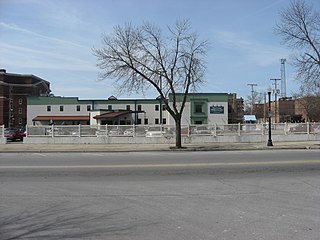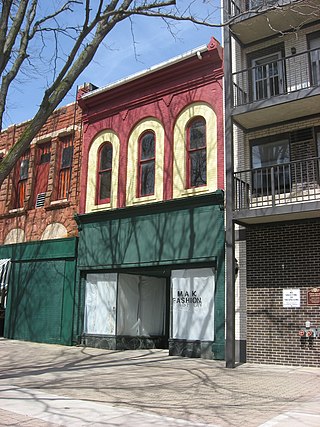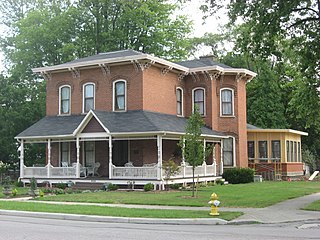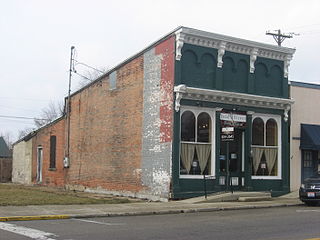
The Saxony Apartment Building is a historic apartment building in Cincinnati, Ohio, United States. Located along Ninth Street in the city's downtown, this five-story brick building includes a distinctive range of architectural details. Among these elements are brick pilasters and projections, a three-story bay window on each side of the symmetrical main facade, semicircular balconies, and many stone pieces, such as pediments, keystones, and stringcourses. Due to its location at the intersection of Ninth and Race Streets, the Saxony appears to have two fronts: one onto each street. Although the Ninth Street facade is larger and more complex, the Race Street facade is nevertheless ornate as well: it features small yet elaborate semicircular balconies with wrought iron railings similar to those of the Ninth Street facade.

The Armory–Latisona Building is a historic armory on South Main Street in Lima, Ohio, United States. Built in 1896, it features a Victorian variant of the Romanesque Revival style of architecture.

The Commercial Building is a historic skyscraper in central Dayton, Ohio, United States. Constructed in the early twentieth century, it played an important part in the development of the western portion of downtown Dayton, and it is one of the most prominent surviving examples of the work of one of the most significant architects in the city's history. Located at the edge of what was once one of the city's leading commercial complexes, it has been named a historic site.

The United States Post Office in Lima, Ohio, United States is a historic Neoclassical building erected in 1930. Located along High Street west of the center of the city, the post office is one of the newest major buildings in the city's downtown.

The First National Bank and Trust Building is a historic building on Public Square in downtown Lima, Ohio, United States. The rectangular building, completed in 1926, was designed by Weary & Alford Company, an architectural firm from Chicago. It was the location of the offices of the First National Bank and Trust Company from 1926 until 1974, when the company became a part of Huntington Bank. The structure's twelve stories are faced with Indiana Limestone. Each column of windows is topped with an arch window on the highest floor, and the spandrels between the arch windows are connected to each other.

The Union Block is a historic business building on Public Square in downtown Lima, Ohio, United States. Built in 1878, it is a three-story brick building with a modified rectangular floor plan and a sloping roofline.

The Klaus Block is a historic building in downtown Lima, Ohio, United States. Built along Main Street in 1870, it is a rectangular three-story structure built in a Victorian variant of the Gothic Revival style of architecture. The exterior features a simple rectangular shape of three bays on each side, topped with a hip roof of asphalt. Decorations such as brick corbelling and stone trim highlight the interior.

The Dorsey Building was a historic commercial building in Lima, Ohio, United States. Located along South Main Street in the city's downtown, it was built in a transitional style of architecture in 1899. Among its most distinguishing features was elaborate stonework, which was deemed equal to that of the adjacent Linneman Building and superior to that of all other Lima buildings. Like the Linneman Building and several other buildings on South Main, the Dorsey Building was constructed during a period of great prosperity in Lima: the railroad industry was expanding, and the discovery of petroleum in the vicinity had led to an economic boom in the city's economy.

The Beck and R.C. Cahill Buildings [sic] was a historic commercial building on the southern side of downtown Lima, Ohio, United States. Built in 1890 in a late version of the Victorian style, the building was located along Main Street south of the city's central square. It appears that the buildings no longer exist.

The Renz Block was a historic commercial building in downtown Lima, Ohio, United States. Located along North Main Street across from the Allen County Courthouse, the block was built in 1900 in a late variant of the Victorian style. A three-story building, the Renz Block was constructed primarily of brick with stone details; the roof was flat and made of asphalt. Among its leading aspects were an elaborate parapet and a heavily decorated facade, including windows with doubly sashed transom lights.

The Hotel Argonne is a historic hotel in downtown Lima, Ohio, United States. Built in 1919, the hotel was dedicated to veterans of the Meuse-Argonne Offensive during the recently concluded World War.

The Lima Cleaning and Pressing Company Building is a historic structure located along South Main Street in Lima, Ohio, United States. Built in 1890, it is an example of an early style of commercial architecture.

The Martin and Kibby Blocks are a pair of historic buildings in downtown Lima, Ohio, United States. Erected in 1884, they are brick structures built in the Victorian Gothic style of architecture. Both buildings are rectangular structures, three-stories tall, and topped with sloped roofs of asphalt. Among the decorative elements present on these buildings are brick pilasters next to the main entrances, stone lintels around the windows, and decorative corbelling between the structural brackets.

The Ohio Theatre is a historic movie theater in downtown Lima, Ohio, United States. Built in 1927, the theater is a brick and concrete structure featuring multiple architectural styles. Outside, large amounts of terracotta details produce a Churrigueresque appearance, while Corinthian columns, marble and mosaic floors, and a massive chandelier produce an Italianate interior.

The Neely–Sieber House is a historic house on the west side of Lima, Ohio, United States. Designed by George S. Mills and built in 1904, the house combines elements of the Colonial Revival and Georgian architectural styles.

The Metropolitan Block is a historic commercial building along North Main Street in downtown Lima, Ohio, United States. Built in 1890 at the middle of Lima's petroleum boom, it is historically significant as a well-preserved example of Romanesque Revival architecture.

The Neal Clothing Building is the oldest existing building on the central square of Lima, Ohio, United States. Built before the end of the Civil War, it has been recognized as historically significant as a representative of the city's earliest period.

The Jones–Read–Touvelle House is a historic building in Wauseon, Ohio, United States. Located along Park Street south of downtown, this ornate brick house sits on a corner lot adjacent to a city park. Architectural historians have seen the Jones–Read–Touvelle House as a fine example of the combination of multiple architectural styles: most of the house itself appears to be Italianate, but the porch and some of the other details are plainly those of the Queen Anne style.

St. Rose's Catholic Church is a historic Catholic church in St. Rose, an unincorporated community in Marion Township, Mercer County, Ohio, United States.

The Village Hobby Shop is a historic building in the village of Mechanicsburg, Ohio, United States. Built on Main Street in the late 19th century, it is one of the village's oldest extant commercial buildings, and it has been named a historic site.

























